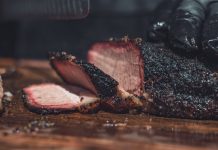
On a snowy morning in February, I walked into my kitchen to take stock. It was a disaster from the cupboards and countertops to the fridge and floor. Appliances normally hidden away (the panini press, Cuisinart food processer, and waffle maker), were now visible, crowding out the coffee machine, toaster, and blender. My alphabetized spices were a jumble (the turmeric was next to the allspice), and the pantry a muddle of once-separated canned and dry goods. Inside the refrigerator, leftovers languished, while under my slippers, crumbs crackled. With the kitchen finally empty of house guests, I went to work reclaiming my precious space.
Since March 2020, my husband and I have seen a cohort of friends and family safely test into our house to quarantine for various amounts of time. While I have relished every minute of having loved ones nearby, relinquishing my kitchen, even to my most beloved fellow cooks, has proved challenging.
The kitchen is my sanctuary, the place I rule in our chaotic house, also inhabited by my husband, my 87-year-old mother, and my 62-year-old brother. It has always been my refuge, no matter where it is located. We lived abroad for 20 years with our three children, and though each kitchen was decidedly different, my favorite dishes, gadgets, mixing bowls, and pots weathered each journey to end up on my shelves in London, Paris, Brussels, and finally Cairo. Ten years ago, I once again packed up my kitchen, but this time to repatriate to my hometown in Ann Arbor and, more significantly, to my parents’ home of 25 years that we had just purchased with my parents still in residence.
Setting up our multigenerational kitchen meant finding a place for my soufflé dish next to my mother’s Jell-O mold and my spiralizer next to her potato peeler. One thing we did not merge was our kitchen skills. After nearly 60 years of marriage, my mother was more than happy to sip a cocktail with my father rather than make another family meal. So, for the last decade it has been my domain.
Then COVID hit. Soon after, all of our three 20-something children returned home for a while, each with a culinary wish list. Charles loves to bake and wanted to spoil us with cookies. But what comes with a plate of his warm Snickerdoodles is a sink full of mixing bowls and a floor dusted in flour. What I found endearing when he was a teen, I found annoying during a pandemic when I was regularly preparing three meals a day.
Florence, who has never really cooked, wanted to learn as we sheltered in place. But what should have been a lovely mother/daughter bonding experience felt dangerous in our small kitchen. Not wanting to scald or stab her, I finally parked her in a chair so she could watch from a safe distance, like a cooking show.
Harriet arrived with her girlfriend, Liz, who is vegetarian. They wanted to introduce me to the joys of meatless cooking. In days, the refrigerator was filled with tofu, almond milk, and Boca burgers, and the kitchen covered in leafy greens. Now it was I who watched from afar as Liz pulsed chickpeas into hummus and Harriet sprinkled curry powder into pots of root vegetables.
Like all of us, COVID-19 has forced me to compromise. Six months into the pandemic, I was no longer complaining if I found a whisk with the wooden spoons. Then, three of our single friends showed up, weary of quarantining alone, and overlapped one weekend. Friday night, David had sent ahead two boxes with the fixings for a “sweet-and-sour happy hour.” One held a dozen pouches of pickles with names like Sour Sis, Hot Mama, Garlic Joe, and Big Papa, while the other held a jug of Jelly Beans and a bottle of cake vodka. While we sampled pickles and sipped candy martinis on our kitchen island, the champagne and charcuterie I’d planned never materialized.
Saturday, our friend Stuart made us a dish he had learned during quarantine: skillet chicken with seared asparagus. Stuart is a precise cook who wants his food consumed the moment it leaves the flame. While he splattered my kitchen with olive oil, soy sauce, and red pepper flakes, I joined the others in front of the fire, herding them to the table the moment I heard the poultry hit the plate. Sunday, it was Wendy’s turn. Braised short ribs with a four-hour prep time were on her menu. I distracted myself from the number of pans she would be using by finishing a work project, the glorious smell of roasting meat in red wine calming my nerves.
That evening, between bites of beef that cut like butter, I had a flashback to Thanksgiving 2019. My father had just died and we had held his memorial the weekend before the holiday. Knowing we had a house full of out-of-town relatives, my dear friend Katherine, who happens to own and run a local catering company, brought Thanksgiving dinner to our home. Weary and grief-stricken, I watched as she stirred the gravy, carved the turkey, and located serving dishes I did not even know we had.
I suddenly realized cooking is how I have always shown love, whether making my children’s favorite pasta when we moved to a new country or making my mom’s meatloaf for my father when he was suffering from cancer. During the pandemic, I have cooked like a fiend, trying to nurture those around me with freshly baked bread, hearty soups, and decadent sweets. My friends and children simply wanted to do the same for me.
I raised my glass, toasted my friends, and thanked them before asking Wendy what was for dessert. The next morning, my dishwasher broke. Even my kitchen knew I needed a break.
|
|
|









